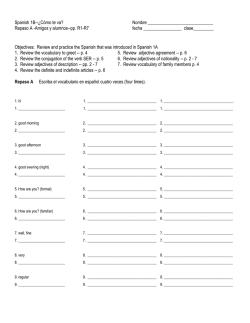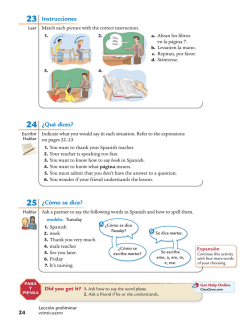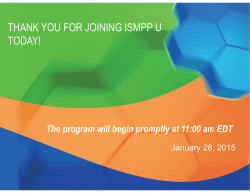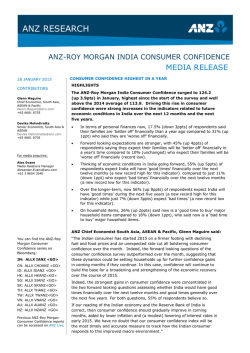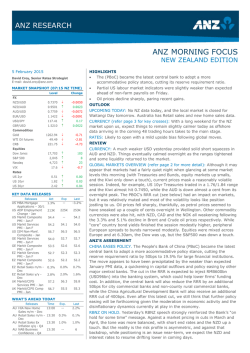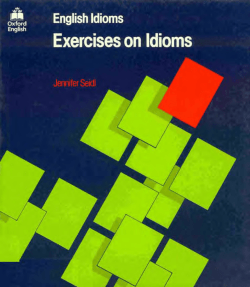
Estudios de lingüística inglesa aplicada ELIA Journal GUIDELINES
177 ELIA Journal Estudios de lingüística inglesa aplicada ELIA Journal GUIDELINES FOR PUBLICATION 1. The article must be original (i.e., unpublished). Only one article per author will be accepted in each issue. 2. Articles will be preferably written in English although Spanish will also be accepted. In case the manuscript that is sent for consideration has been written in a language other than the author’s mother tongue or dominant language, it must have been proofread by a qualified native reviewer. The full manuscript should be presented in a Word document and sent as an attachment by email to the following address: [email protected] 3. A cover letter must also be sent as an attachment. The letter should contain the following information: (i) author’s/authors’ name/s, (ii) full postal and email addresses, (iii) paper’s title in both English and Spanish, (iv) author’s statement that the manuscript submitted has not been published elsewhere, or is in press or currently being reviewed for publication, (v) author’s biodata (approx. 15 lines) including the following information: (a) university-level training/preparation, (b) ELIA 14, 2014, pp. 177-181 Guidelines for publication 178 teaching experience (including present institutional affiliation, current academic position/rank, and area/s of specialization), and (c) recently published work. 4. The article must conform to the following sequence: (a) title, (b) author’s/ authors’ name/s, (c) institutional affiliation/s and country/countries, (d) email address/es, (e) abstract in English and Spanish, (f) key words in English and Spanish, (g) main text, (h) (acknowledgements), (i) (notes), (j) references, (k) (appendixes). 5. The title (max. 15 words) in bold capital letters will head the article. Under the title and in italics, the author’s/authors’ name/s should be provided; under the author’s name and also in italics, the institution and country must be included, separated by a comma. Under the institution and country, the author’s/authors’ email address must be provided. 6. The article must be written in the same language as the title. 7. A 150-250 word single-spaced abstract written in italics must precede the text with the same margins as in the body of the text. The same summary must be provided both in English and in (properly edited) Spanish. The words Abstract / Resumen must not precede the summary. 8. Between 4 and 6 essential words/phrases, written in italics and provided both in English and Spanish, should be included under each abstract, preceded by the expressions Key words / Palabras clave. 9. Maximum length of contributions will be 30 pages, reference list and appendixes included. 10. Margins: top 6.2 cm, bottom 6 cm, left and right 4.5 cm. Line spacing: 1.1. 11. Paragraphs should be indented 1.25 cm., except for the first one after a section title. ELIA 14, 2014, pp. 177-181 179 ELIA Journal 12. Section titles should be on a separate line, written in bold, not underlined, and preceded by a number starting from one. No dot should be used at the end of a section title (e.g., 1. Introduction). The first letter of each word should be capitalized, except for function words (i.e., prepositions, conjunctions, and articles). Subsections titles should also be on a separate line, written in bold, not underlined, and not indented. No dot should be used at the end of a subsection title (e.g., 1.1. Reading Comprehension and Vocabulary). Further divisions (e.g., 1.1.1., 1.1.2.) should not be used. 13. Times New Roman 11 should be the basic font for the text of the article. However, acknowledgments, examples, excerpts, figures, (numbered) lists, notes, quotations, references (bibliography), and tables must use Times New Roman 10. Words not belonging to the language in which the article is written should be in italics. 14. Pages must not include headers, footers or numbers. 15. Do not use capital letters to provide emphasis. Instead, use italics for letters, words, or phrases cited as linguistic examples as well as key, technical, or new terms/concepts. In general, italics and boldface should not be overused. 16. Punctuation, abbreviations, quotations, notes, reference list, tables, figures, appendixes, and reference citations in text should follow the American Psychological Association (APA, http://www.apastyle. org/pubmanual.html) editorial style (e.g., editorial style used in Studies in Second Language Acquisition, SSLA). 17. For any other format-related information not specified above, please contact the journal editor (see # 2 above) to request a sample article. 18. The reference list should be preceded by the section title References (without number). All in-text citations must be listed in full in the reference list. Only those in-text citations should appear in the reference list. Consider the following examples: ELIA 14, 2014, pp. 177-181 Guidelines for publication 180 Aitchison, J. (1994). Words in the mind. An introduction to the mental lexicon. 2nd edition. Oxford: Blackwell. Ard, J., & Homburg, T. (1992). Verification of language transfer. In S. Gass & L. Selinker (Eds.), Language transfer in language learning (pp. 47-70). Amsterdam: Benjamins. Bower, D. L. (1993). Employee assistant programs supervisory referrals: Characteristics of referring and nonreferring supervisors [CD-ROM]. Abstract from: ProQuest File: Dissertation Abstracts Item: 9315947 Eckman, F. R. (1993, April). Local and long-distance anaphora in second language acquisition. Paper presented at the American Association of Applied Linguistics Annual Conference, Atlanta, GA. Funder, D. C. (1994, March). Judgmental process and content: Commentary on Koehler on base-rate [9 paragraphs]. Psycoloquy [On-line serial], 5 (17). Available FTP: Hostname: princeton.edu Directory: pub/harnad/Psycoloquy/1994. volume.5 File: psycoloquy.94.5.17.base-rate.12.funder Lakshmanan, U. (1989). Accessibility to Universal Grammar in child second language acquisition. Unpublished doctoral dissertation, University of Michigan, Ann Arbor. Meisel, J. (Ed.). (1994). Bilingual first language acquisition: French and German grammatical development. Amsterdam: Benjamins. Meyer, A. S., & Bock, K. (1992). The tip-of-the-tongue phenomenon: Blocking or partial activation? [On-line]. Memory & Cognition, 20, 715-726. Abstract from: DIALOG File: PsycINFO Item: 80-16351 ELIA 14, 2014, pp. 177-181 181 ELIA Journal Pica, T. (1994). Research on negotiation: What does it reveal about second-language learning conditions, processes, and outcomes? Language Learning, 44, 493-527. Schachter, J., Rounds, P., Wright, S., & Smith, T. (in press). Comparing conditions for learning syntactic patterns: Attentional, nonattentional, and awareness. Applied Linguistics. Swain, M. (1995). Three functions of output in second language learning. In G. Cook & B. Seidhofer (Eds.), For H. G. Widdowson: Principles and practice in the study of language (pp. 125-144). Oxford: Oxford University Press. The Research Group “La lengua inglesa en el ámbito universitario” HUM397, represented by the University of Seville (Spain), holds the copyright of published articles and allows their reuse licensed by Creative Commons: Attribution-NonCommercial-NoDerivs License 4.0 International: you may copy, use, distribute, transmit and publicly display these published articles, provided that (a) the original authorship and publication source is acknowledged, (b) it is not used for commercial purposes, and (c) the existence and specifications of this license are mentioned. ELIA is an open access journal. Regarding the conditions of self-archiving, authors are allowed to archive post-print version for non-commercial purposes including repositories and personal websites. Conditions for self-archiving can be consulted at: http://www.accesoabierto.net/dulcinea/ consulta.php?directorio=dulcinea&campo=ID&texto=1716 ELIA 14, 2014, pp. 177-181
© Copyright 2025
